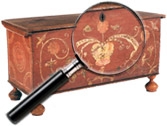|
|
Lard Fueled Lamps
The introduction of lard lamps, circa 1835, came in response to the widespread use of whale oil and other fluid oil lamps. These liquid fuels were dangerous to handle and the less expensive grades were smokey and poor illuminators. Lard, on the other hand, was safer as a solid, easily stored and could be inexpensively made at home.
The primary difficulty with lard was getting the thick fat to flow up [...] Click here to continue reading.
Definition: ‘Pickwick’
A “pickwick” is a small tool used, circa 1830 to 1870, to manipulate or adjust the wick in whale oil and burning fluid lamps. The tool was commonly a metal pin held in a decorative handle of turned or carved wood, ivory or bone, and occasionally glass.
Quezal Art Glass
Named for the Central American Quetzal – a bird with brilliantly colored plumage – the Quezal Art Glass and Decorating Co. was founded in 1902 by two glassmakers, Martin Bach and Thomas Johnson, formerly working with Louis Comfort Tiffany. Their products were very similar to Tiffany’s art glass work like “Favrile” in its iridescent forms of blue, green, gold and white. Because of its quality and technical excellence the company soon [...] Click here to continue reading.
Consolidated Lamp & Glass Company
The Consolidated Lamp and Glass Company was formed in Fostoria, Ohio in 1893 from the merger of the Fostoria Shade and Lamp Company with Wallace and McAffee Company. They moved to Coraopolis, Pennsylvania when their glassworks burned down in 1895. In the 1890′s they produced some art glass vases and bowls, but for many years their main production was high quality lamps, globes and shades. Beginning in 1925 its [...] Click here to continue reading.
Ruba Rombic Glass & Muncie Pottery
In 1927 Reuben Haley designed an Art Deco line of glassware called Ruba Rombic for the Consolidated Glass Company of Coraopolis, Pennsylvania. This art glass line was introduced to the trade in January 1928 at the annual industry show at the Fort Pitt Hotel in Pittsburgh. Consolidated produced all the Ruba Rombic wares except for a very rare fish bowl produced by the Phoenix Glass Co.
All Ruba [...] Click here to continue reading.
Slag Glass
Slag glass is defined as colored, opaque glass wih an altenate color swirled throughout giving the appearance of marbling. For this reason it is sometimes called marble or malachite or mosaic glass. Popular colors include butterscotch, green and purple. The name has been used by glass-makers only in recent times and is derived from the belief that the colors were acheived by adding “slag” from iron smelting works to the glass.
[...] Click here to continue reading.
Durand Art Glass
Durand Art Glass was produced for seven brief years (1924 to 1931) in Vineland, New Jersey, by Victor Durand Jr, a French immigrant who owned and operated the successful Vineland Flint Glass Works which produced various lines of commercial wares. The Flint works had been founded with Durand’s father in 1897. A man with foresight and ingenuity, Durand Jr. was the first to produce a thermos bottle in this country along [...] Click here to continue reading.
Sevres Porcelain
Sevres Porcelain is known for its high quality, gilded and hand-painted decoration and wealthy and aristrocratic clientele, the French Sevres Porcelain Factory was founded in 1738 at Chateau de Vincennes, by local craftsmen from a nearby porcelain factory at Chantilly.
Louis XV, the French “Sun King”, was a partial owner of the Sevres works and granted them a twenty year monopoly along with the title of Royal Manufacturer of Porcelain. Circa 1759 [...] Click here to continue reading.
Burmese Pattern Glass
The Mt. Washington Glass works of Boston, Massachusetts, obtained a patent on Burmese Art Glass in 1885. The new glass form had been created for them by the Englishman Frederick Shirley and is characterized by a gradual shading of bright yellow at the base of the object to a pink at the top.
This unique blend of colors was created by adding gold and uranium to the glass, which is thin [...] Click here to continue reading.
The Handel Company
Handel & Co. was formed in 1892 when Philip Handel bought out the partner with whom he had formed Eyden & Glass Decorators seven years earlier. The company became Handel Company, Inc. in 1904. The new company began manufacturing leaded glass shades for oil and gas lamps, as well as the new ‘electroliers’, in the late 1890′s and continued doing so until they closed their doors in 1936.
One of Handel’s [...] Click here to continue reading.
|
Recent Articles
- Charles Alfred Meurer – American Artist & Tromp L’Oeil Artist
- Sendak, Maurice – American Artist & Writer
- Godie, Lee – American Artist
- Davis, Vestie – American Artist
- Bartlett, Morton – American Artist
- Mackintosh, Dwight – American Artist
- Evans, Minnie Jones – African-American Artist
- Mumma, Ed (Mr. Eddy) – American Artist
- Nice, Don – American Artist
- Savitsky, John (Jack) – American Artist
- Gordon, Harold Theodore (Ted) – American Artist
- Dial, Thornton – African-American Artist
- Doyle Sam – American Artist
- Johnson, Lester Frederick – American Artist
- Finster, Howard – American Artist
|
|
